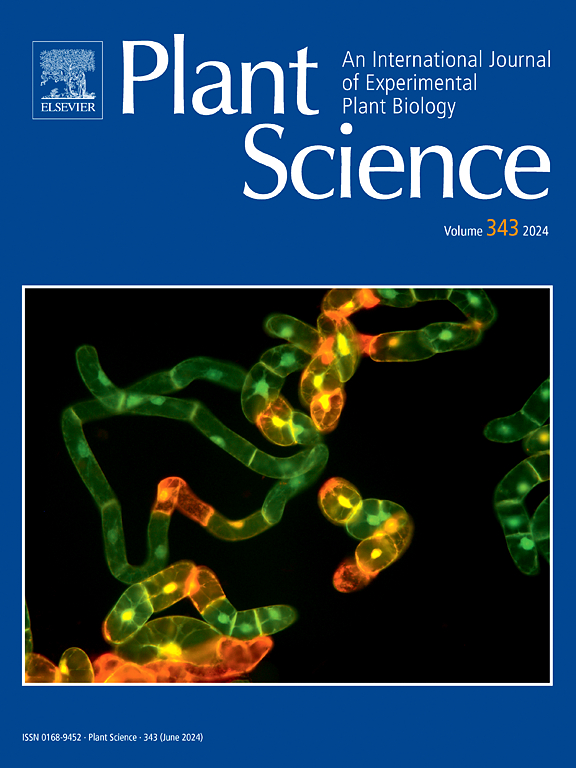茄科植物的科系关系及其对盐度的适应。
IF 4.2
2区 生物学
Q2 BIOCHEMISTRY & MOLECULAR BIOLOGY
引用次数: 0
摘要
地下竞争受到邻近植物的存在和特性以及环境条件的影响。研究了盐胁迫对茄科近缘植物亲缘度(DOR)的影响。在对照和盐胁迫条件下,以高(H) DOR (CC和BB)和低(L) DOR (CB)为对照,单独或成对栽培樱桃番茄(Solanum lycopersicum L.)和甜椒(Capsicum annuum L.)植株。对比植株对DOR和处理的响应,甜椒对樱桃番茄有利,增加了CO2同化(A)、气孔导度(gs)、株高(H)、茎和根生长、木质部面积和根呼吸,因此在L-DOR配对下,樱桃番茄对盐度的适应更好。盐胁迫下甜椒的A、gs、H、生物量、根系解剖结构和细根增殖均受到损害,根系呼吸显著增加,尤其是L-DOR配对。三羧酸循环(TCA)中基因的表达也受到邻居存在的影响,从而影响呼吸速率。因此,对盐度的适应是物种特异性的,取决于邻居的存在和DOR,这表明在极端环境约束下种植具有不同DOR的主要作物可以提高可持续农业的胁迫耐受性。摘要:研究了茄科近缘植物在盐度胁迫控制下,与近缘植物(H-DOR)或远缘植物(L-DOR)单独生长(即自生)的主要生理、代谢、解剖反应的代表性。随着DOR的降低(单个红色箭头向下表示),樱桃番茄通过细根的存在增加了CO2同化(A)和气孔导度(gs)、株高(H)、茎和根的生长,增加了比根长(SRL)和比根面积(SRA),增加了根呼吸(双蓝色箭头表示),同时减少了根干重和木质部面积(单个红色箭头表示)。相反,随着DOR的降低,甜椒的A、gs、H、茎部和根系生物量以及根系解剖结构(用双红色箭头表示)等几个性状都有所降低,同时细根的增殖,SRL和SRA增加,根呼吸显著增加(用单个蓝色箭头表示)。本文章由计算机程序翻译,如有差异,请以英文原文为准。
Family ties and acclimation to salinity in Solanaceae
Belowground competition is affected by the presence and identity of neighboring plants, as well as by environmental conditions. We examined the effects of the degree of relatedness (DOR) of neighboring Solanaceae relatives under salinity stress vs. control. Cherry tomato (Solanum lycopersicum L.) (C) and bell pepper (Capsicum annuum L.) (B) plants were grown individually or in pairs of high (H) DOR (CC and BB) and low (L) DOR (CB), under control and salinity conditions. In comparisons of plant responses to DOR and treatments, cherry tomato benefited from the presence of bell pepper, with increased CO2 assimilation (A), stomatal conductance (gs), plant height (H), shoot and root growth, xylem area and root respiration, thus acclimating better to salinity with L-DOR pairing. In contrast, salinity-stressed bell pepper showed impairment in A, gs, H, biomass, root anatomy, and proliferation of fine roots with significantly increased root respiration, especially with L-DOR pairing. Expression of genes in the tricarboxylic acid cycle (TCA) was also affected by the neighbor’s presence, influencing respiration rate. Acclimation to salinity is, therefore, species-specific and depends on the neighbors’ presence and DOR, suggesting that cultivating major crops with different DORs under extreme environmental constraints could increase stress tolerance for sustainable agriculture.
求助全文
通过发布文献求助,成功后即可免费获取论文全文。
去求助
来源期刊

Plant Science
生物-生化与分子生物学
CiteScore
9.10
自引率
1.90%
发文量
322
审稿时长
33 days
期刊介绍:
Plant Science will publish in the minimum of time, research manuscripts as well as commissioned reviews and commentaries recommended by its referees in all areas of experimental plant biology with emphasis in the broad areas of genomics, proteomics, biochemistry (including enzymology), physiology, cell biology, development, genetics, functional plant breeding, systems biology and the interaction of plants with the environment.
Manuscripts for full consideration should be written concisely and essentially as a final report. The main criterion for publication is that the manuscript must contain original and significant insights that lead to a better understanding of fundamental plant biology. Papers centering on plant cell culture should be of interest to a wide audience and methods employed result in a substantial improvement over existing established techniques and approaches. Methods papers are welcome only when the technique(s) described is novel or provides a major advancement of established protocols.
 求助内容:
求助内容: 应助结果提醒方式:
应助结果提醒方式:


